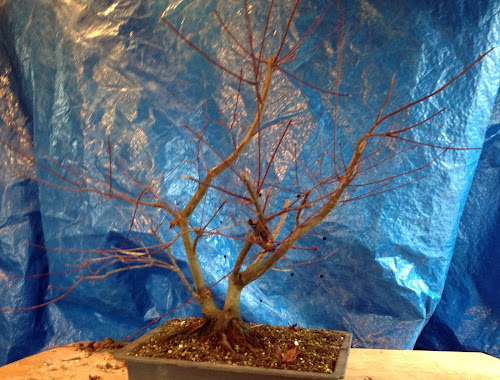WTF moment this year...continuing the unpredictable weather and the frankly appalling conditions in which to try and cultivate bonsai, I was mildly shocked yesterday morning when I got back at 5 a.m from a long drive back from Cornwall. Having spent three days in the company of Marcus Watts, talking bonsai, fishing and fertilising, I drove back for a day at home where I thought I could get some stuff done. First job is to always go out and check on the kids, and despite the weather, they were fine. The polytunnel was a toasty 0.3 degrees C, which isn't an issue, but by torch light I found these critters all over my deshojo maples, and starting o have a go at a few other trees.
I could barely believe my eyes, 0.3 degrees and aphids all over my tender shoots. After rubbing my eyes to make sure I wasn't seeing stuff, I went to bed for a few hours before coming down to sort them out.
Using a polytunnel or green house is fast becoming an essential part of bonsai in the UK and for many of youze lot around the globe. For those in warm climates who don't need one...aren't you lucky. One of the problems with using such a contraption and creating an unnatural micro climate and then cramming trees in there is that problems can and will arise. Insects will wake up early and fungal spores can spread like wildfire. What can be done then?
Prevention is better than cure, especially as we are hamstrung by Defra in terms of effective chemicals over the counter, so Provado is your best friend. It is a systemic pesticide, which means it gets into the system of the tree and works from the inside out. Any critters who start to suck sap, take a dose of poison with it and then shuffle off this mortal coil. So, how do we get this into the system? Spraying on the leaves won't work because there aren't any...so we must use a root drench. The most effective way of using Provado is to dunk your trees, pot and all into a bath of diluted Provado and allow the soil to absorb it, subsequently the roots will suck it up and we are all systems go. If this is impossible then make up a watering can full, or a sprayer or whatever and carefully drench the soil. This should prove effective for 6 to 8 weeks, which will see you through the spring period when aphids et al. tend to attack. A trusted source (Ken Leaver, nurseryman extraordinaire) assures me it is good all year round. Most trees will benefit from it, although there are some which are much less likely to be affected by insects.
Curing trees with infestations is more difficult, as contact killers are less available. Pyrethrin is your best bet in the UK, although it is unstable in sunlight and high temperatures so be careful in storing it and also the time of day you spray it. I have some and some ahem...slightly err...older chemicals stockpiled, so I can kill them. Which is hopefully what I did yesterday. I sprayed the tops with Pyrethrin and did the roots with Provado, so next time I see the trees, they should be ok.
Fungal issues are also a major, major concern for polytunnel users. Moist conditions, stale, stationary air and higher temperatures = fungal heaven. Preventative spraying of fungicides is recommended from whenever the temperature inside gets above 10 degrees. Also ensuring airflow with either a fan or opening the doors, will help. When you water the trees, don't water the foliage unless it will have a chance to dry out before the temperatures drop of an evening. Spraying pines once a month between now and august/september with two different fungicides will help if you suffer from any needle cast or more serious fungal issues. Try not to get too much in the soil if you can, but a little will not be of any harm. Alternate between two products, the only two out there. Always check the active ingredient and do some research online if unsure.
For those who are totally organic and want to use soaps and oils and stuff, then by all means do. I live as much in harmony with the environment as I can, but no masterpiece bonsai in Japan ever got that way with Neem Oil. Sorry...
Health and Safety warning. Be careful with chemicals. Mask, gloves, goggles. Measure the concentrate and do exactly as instructed on the tin. Do not spray in the direct sun (ha!) or wind as this reduces effectiveness and gets all up in your face, leading to spluttering and a nasty aftertaste and potential reduction in male sperm count...for blokes obviously. If you look at the dodgy scientific facts, almost all bonsai masters who are careless with their chemicals...they all have daughters. The Chief, 3 girls, Reg Kimura, 2 girls, Akiyama, 2 girls...the list goes on. Me? Well no nights at home = no girls.
I'm now halfway through the spring season and only got a few more hectic weeks ahead. I'm off to Athens next week and I am truly truly looking forward to it. I may even get chance for a little bit of sunshine.





































